Lepisosteus is a genus of gars in the family Lepisosteidae.

Forster's tern is a tern in the family Laridae. The genus name Sterna is derived from Old English "stearn", "tern", and forsteri commemorates the naturalist Johann Reinhold Forster.
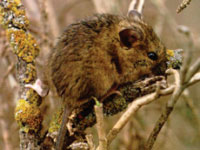
The salt-marsh harvest mouse, also known as the red-bellied harvest mouse, is an endangered rodent endemic to the San Francisco Bay Area salt marshes in California.

The delta smelt is an endangered slender-bodied smelt, about 5 to 7 cm long, in the family Osmeridae. Endemic to the upper Sacramento-San Joaquin Estuary of California, it mainly inhabits the freshwater-saltwater mixing zone of the estuary, except during its spawning season, when it migrates upstream to fresh water following winter "first flush" flow events. It functions as an indicator species for the overall health of the Delta's ecosystem.

Located in northern California, the Suisun Marsh has been referred to as the largest brackish water marsh on west coast of the United States of America. The marsh land is part of a tidal estuary, and subject to tidal ebb and flood. The marsh is home to many species of birds and other wildlife, and is formed by the confluence of the Sacramento and San Joaquin rivers between Martinez and Suisun City, California and several other smaller, local watersheds. Adjacent to Suisun Bay, the marsh is immediately west of the legally defined Sacramento-San Joaquin Delta as well as part of the San Francisco Bay estuary.
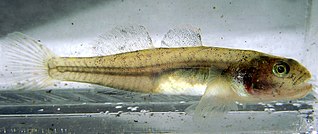
Eucyclogobius newberryi, the northern tidewater goby, is a species of goby native to lagoons of streams, marshes, and creeks along the coast of California, United States. The northern tidewater goby is one of six native goby species of California. It is protected under the Endangered Species Act as an endangered species of the United States since 1994.

Rodeo Lagoon is a coastal lagoon located in the Marin Headlands division of the Golden Gate National Recreation Area, which is in southern Marin County, California. This brackish water body is separated from the Pacific Ocean by a sand bar that forms Rodeo Beach. Rodeo Lagoon stretches approximately 900 metres (3,000 ft) by 250 metres (820 ft), and is about 2 metres (6.6 ft) deep at its maximum depth. It covers a surface area of about 15 hectares.

San Gregorio Creek is a river in San Mateo County, California. Its tributaries originate on the western ridges of the Santa Cruz Mountains whence it courses southwest through steep forested canyons. The San Gregorio Creek mainstem begins at the confluence of Alpine and La Honda Creeks, whence it flows 12 miles (19 km) through rolling grasslands and pasturelands until it meets the Pacific Ocean at San Gregorio State Beach. It traverses the small unincorporated communities of La Honda, San Gregorio, Redwood Terrace and Sky Londa.

The Gobiiformes are an order of fish that includes the gobies and their relatives. The order, which was previously considered a suborder of Perciformes, is made up of about 2,211 species that are divided between seven families. Phylogenetic relationships of the Gobiiformes have been elucidated using molecular data. Gobiiforms are primarily small species that live in marine water, but roughly 10% of these species inhabit fresh water. This order is composed chiefly of benthic or burrowing species; like many other benthic fishes, most gobiiforms do not have a gas bladder or any other means of controlling their buoyancy in water, so they must spend most of their time on or near the bottom. Gobiiformes means "goby-like".
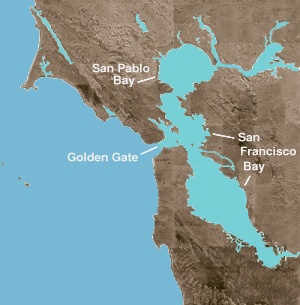
The San Francisco Estuary together with the Sacramento–San Joaquin River Delta represents a highly altered ecosystem. The region has been heavily re-engineered to accommodate the needs of water delivery, shipping, agriculture, and most recently, suburban development. These needs have wrought direct changes in the movement of water and the nature of the landscape, and indirect changes from the introduction of non-native species. New species have altered the architecture of the food web as surely as levees have altered the landscape of islands and channels that form the complex system known as the Delta.
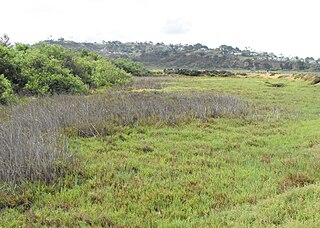
Brackish marshes develop from salt marshes where a significant freshwater influx dilutes the seawater to brackish levels of salinity. This commonly happens upstream from salt marshes by estuaries of coastal rivers or near the mouths of coastal rivers with heavy freshwater discharges in the conditions of low tidal ranges.

The violet goby is a species of goby native to marine, fresh and brackish waters near the Atlantic coast of North and South America from South Carolina in the United States of America, to northern Brazil. It prefers bays, estuaries and river mouths with muddy substrates. It is often marketed as the dragon goby or dragon fish.

Tridentiger is a genus of fish in the subfamily of gobies called the Gobionellinae, known commonly as the tripletooth gobies.

The chameleon goby is a species of ray-finned fish native to marine and brackish waters along the coasts of eastern Asia. It has also spread to other parts of the world where it is found in waters with varying degrees of salinity.

Organisms targeted by NISA are categorized as aquatic nuisance species, including in particular zebra mussels and Eurasian ruffe. To extend upon NANPCA, NISA authorizes regulation of ballast water, a key factor in the spread of aquatic invasive species; funding for prevention and control research; regional involvement with the Aquatic Nuisance Species Task Force; and education and technical assistance programs to promote compliance with the new regulations. NISA also includes specific actions for certain geographical locations, such as the Great Lakes, Chesapeake Bay, the Gulf of Mexico, and San Francisco Bay.

The Shokihaze goby is a species of goby native to marine and brackish waters along the coasts of eastern Asia. It has also been introduced to the San Francisco Bay in California, United States. This species can reach a length of 5.2 centimetres (2.0 in) SL.

Acanthogobius flavimanus is a species of fish in the goby family known by the common name yellowfin goby. Other common names include mahaze, Japanese river goby, Oriental goby, and spotted goby. It is native to Asia, where its range includes China, Japan, Korea, parts of Russia, Vietnam, and Malaysia. It has spread beyond its native range to become an introduced, and often invasive, species. It has been recorded in Australia, Mexico, and Florida and California in the United States.
Maeotias is a genus of hydrozoans in the family Olindiidae. It is a monotypic genus with only a single species, Maeotias marginata, commonly known as the Black Sea jellyfish or brackish water hydromedusa and often referred to as Maeotias inexpectata in the literature. It was first described from the Don and Kuban estuaries of the Sea of Azov, and also occurs in the Black Sea, all of which are areas of low salinity. It has been recorded in several other estuarine locations around the world and is regarded as an invasive species.
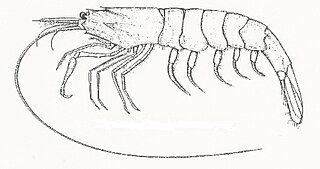
Crangon franciscorum is a species of shrimp in the family Crangonidae which is endemic to the brackish estuaries of California, and found from Puget Sound in the north to San Diego, California in the south. The species is especially abundant in San Francisco Bay, despite population fluctuations due to environmental stresses. Its common names include bay shrimp, sand shrimp, common shrimp, grass shrimp, black shrimp, California shrimp and black tailed shrimp. The species has been commercially fished from 1869 to the present.

Arcuatula senhousia(= Musculista senhousia), commonly known as the Asian date mussel, Asian mussel or bag mussel, is a small saltwater mussel, a marine bivalve mollusk species in the family Mytilidae, the mussels. Other common names for this species include: the Japanese mussel, Senhouse's mussel, the green mussel, and the green bagmussel. It is harvested for human consumption in China.


















